By Dave Liscio.
When the Farr PH 56 Monterey sank in May 2017 during the Antigua-to-Bermuda Race, nobody was more shocked than owner and skipper Les Crane. After all, he’d sailed the boat more than 40,000 miles during the previous 14 years and had confidence in its seaworthiness. The center-cockpit sloop had been updated months earlier and stocked with safety equipment.
Monterey sank approximately 220 nautical miles from Bermuda. All six aboard, including Crane, were rescued by another boat in the race.
“We had become a little complacent,” he said. “We’d been sailing for four months, from Greece to Las Palmas. We’d already done 5,000 miles from Corfu. The crew knew everything about the boat.”
Reflecting on the loss, Crane drafted a list of mistakes made and recommendations about what he should have done differently. Here’s what he told SAILING Magazine:
Drills
Before leaving the dock, conduct drills for abandoning ship and flooding.
“We should have practiced dewatering at the dock. Same with man overboard and getting into the life raft,” Crane said.
Electronic communications
Test the primary VHF radio and masthead antenna before setting sail. Check handheld VHF radios. Know how to use AIS to identify nearby vessels should you require help. Make certain the EPIRB and the satellite phone are registered and functioning. Otherwise they are of limited value.
In Crane’s case, AIS indicated two boats close behind when the sinking occurred, and the satellite phone allowed him to contact Bermuda maritime authorities. At least one other boat heard his radio mayday made using a handheld radio. The Monterey’s masthead radio antenna was not functioning properly in Antigua but the problem was not addressed. As a result, the radio transmission range was significantly reduced.
Assign responsibilities
For the drill, assign crew on each watch to monitor overall boat performance and ensure completion of all tasks. Check seacocks and bilge pumps; coordinate communication using the ship’s radio or portable VHF units; reference the AIS transponder for ships to contact for stand by; prepare satellite phone by pre-programming with primary and secondary contacts; prepare to set off flares and activate the EPIRB; prepare grab bags; ready the life raft for deployment; insert life jackets into a plastic trash bag to keep them dry. The captain should remain unassigned in order to remain free to oversee the emergency. Make it clear to everyone aboard the most important task is to find the leak, and find it quickly.
READ MORE at sailingmagazine.net

